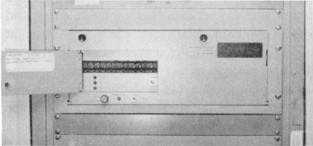1. Tap the face of the barometer lightly with your
finger to reduce the effects of friction.
2. Look straight at the indicator to avoid parallax
error. On the ML-448/UM, align the indicator arm
directly over the reflection on the mirrored surface of
the scale.
3. Read the scale to the nearest 0.005 inch or 0.1
hPa to obtain barometric pressure.
4. Apply any posted correction.
5. Add the appropriate removal correction.
NAVY DIGITAL ALTIMETER SETTING
INDICATOR (DASI)
The Navy Digital Altimeter Setting Indicator
(DASI), shown in figure 2-21, is located at most Naval
meteorology and oceanography detachments and
Marine Corps weather stations. The DASI has an
electronic pressure-sensing element, and the altimeter
values are displayed on a digital LED readout panel.
The panels are located both in the observer’s spaces and
in the control tower. NAVELEX EM-450-AA-OMI-
010-DASI, Operation and Maintenance Instructions,
Digital Altimeter Setting Indicator (DASH), is the
operator’s manual for this system. It may be held by the
air traffic controllers.
The DASI should not be used as a pressure-
measuring instrument. Use of the DASI should be
discontinued when the altimeter setting indicated by the
instrument exceeds the altimeter setting computed from
readings from the ML-448/UM by more than ±0.02
inch.
Unless a Space and Naval Warfare Systems
Command (SPAWARSYSCOM) certified calibration
procedure for the DASI pressure sensor is developed in
the near future, the DASI is expected to be taken out of
service when ASOS is completely installed.
Figure 2-21.—Navy digital altimeter setting indicator (DASl).
MARINE BAROGRAPH
Barographs are instruments used to record or graph
atmospheric pressure over a period of time. The marine
barograph is the only type of barograph found
throughout the Navy and Marine Corps. It is suitable
for use aboard ship and at shore stations. The marine
barograph has not been assigned a military reference
designator.
Barographs are primarily used to determine 3-hour
pressure tendencies for surface aviation weather
observations. Appendix IV shows general barograph
trace patterns used to determine the nine reportable
pressure tendencies. Stations not equipped with a
barograph may report a simplified tendency based on
recorded pressures over a 3-hour period.
The marine barograph (fig. 2-22) is a precision
instrument that measures air pressure either in the
immediate vicinity or at a remote point outside the ship.
The instrument is highly sensitive to changes in
pressure and has linkages that accurately compensate
for changes in temperature. The instrument maintains
its precision aboard ship by the use of an adjustable,
grease-filled, dampening cylinder that cancels out
shipboard vibrations and the pitch or roll of the ship.
Since the air pressure inside a ship may be different
from the outside air pressure (especially when material
condition Yoke or Zebra is set), shipboard marine
barographs should be connected to the outside air.
Shipboard marine barographs are connected to the
exterior of the ship through use of a flexible rubber hose
connected to a fitting on the barograph case.
The marine barograph is equipped with a
“magnified scale” for recording pressure. The
recording chart scale ranges from 965 to 1,050 hPa, but
the instrument has a total usable range from 915 to
1,085 hPa. To prevent the pen arm from recording off
the edge of the chart, you should adjust the pen arm
upward on the scale by 40 hPa during periods of
extremely low pressure, or downward on the scale by 40
hPa during periods of extremely high pressure. The
adjustment is made by turning the adjustment knob.
Because of the magnified scale, high sensitivity, and
accurate temperature compensation, the marine
barograph is sometimes called a "microbarograph."
Operation
NA 50-30BIC-1, the Handbook of Operation,
Service, and Overhaul Instructions for the Marine
Barograph, provides detailed instructions for the
2-15


